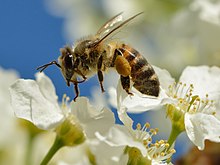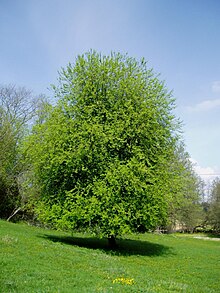Common bird cherry
| Common bird cherry | ||||||||||||
|---|---|---|---|---|---|---|---|---|---|---|---|---|

Common bird cherry ( Prunus padus ) |
||||||||||||
| Systematics | ||||||||||||
|
||||||||||||
| Scientific name | ||||||||||||
| Prunus padus | ||||||||||||
| L. |
The common bird cherry ( Prunus padus L. , Syn .: inter alia Padus avium Mill. , Padus racemosa Lam. ) Is a species of the genus Prunus in the rose family (Rosaceae). The name comes from the in grapes arranged flowers and fruits. It will also Ahlkirsche, swamp cherry or Else Cherry called, rarely, serviceberry , what with the way Sorbus torminalis be confused; in parts of Austria it is called Ölexen, Elexsen, Ölasn, Öxn, Ösn or similar. Prunus padus is also called buckthorn called, because of its brittle branches and bark-like, but has no medical meaning as the True buckthorn .
The late blooming bird cherry from North America is similar .
description
Appearance
The fast-growing common bird cherry grows as a deciduous , dense tree up to 15 meters high or, more rarely, as a shrub up to 10 meters high with overhanging branches. The tree usually forms a low-set and densely leafy crown of slender and conical growth form. Older specimens tend to have a columnar and domed crown. The common bird cherry has a relatively straight trunk that develops a thickness of about 60 cm. The arching branches branch out loosely, the rod-shaped branches often hang over. The common bird cherry is characterized by the great capacity of its roots. The average age of the bird cherry is 60 years, its maximum age is estimated at 80 years.
The bark is smooth and dark gray; if the bark is damaged, the wood gives off an unpleasant, pungent odor. The bark only forms flat, elongated cracks in very old trees.
Vegetative characteristics
The slender buds are long, pointed with an often inwardly curved tip. The 6 to 14 cm long, slightly hairy leaves are on 1–2 cm long petioles. The petiole often has two greenish nectar glands at its upper end . The pointed or pointed leaf blades develop an obovate to elliptical shape . The curved side nerves connected to the finely sawn leaf margin are striking . The underside of the leaf is gray-green in color, the upper side of the leaf is a matt dark green color. The autumn color is yellow-red.
Generative characteristics
The flowering period extends from April to June. The hermaphroditic, white flowers are in 10–15 cm long, initially arching upright, later hanging 12 to 30-flowered clusters that are formed at the end of leafy short shoots. First, they sit alone in the armpit of a carrier sheet , for akropalen end they go into a grape-like inflorescence. Here the bracts are reduced or completely absent. The intensely smelling, bitter almond-like, strictly sweet to pleasantly honey-like blossoms attract various two-winged birds to pollinate .
The five-fold, radially symmetrical, protogyne and stalked flower consists of green sepals that have grown together to form a calyx and white, free petals . The small sepals are fine, glandular-toothed. The spreading petals are about twice as long as the stamens. They have an ovoid to obovate shape. The androeceum on the edge of the flower cup consists of numerous, free stamens , the gynoeceum of, typical for cherries, a carpel . The ovary with a somewhat lateral stylus with less scar represents capitate, medium constantly inside hairy flower cups.
The pea-sized , spherical and wrinkled stone fruit is first red and then glossy black. It ripens in late summer and is eaten by birds that ensure the seeds are dispersed . The tart-bitter tasting pulp is non-toxic. The round to egg-shaped stone core is pointed and has a reticulate, pitted, sculpted structure. It contains poisonous hydrocyanic acid glycosides.
The chromosome number is 2n = 32.
Systematics
One can distinguish between two subspecies:
- Prunus padus L. subsp. padus
- Prunus padus subsp. borealis (A. Blytt) Nyman .
ecology

Hoverflies , bees and butterflies are the main pollinators of the bird cherry . Nectar is offered half-hidden in the flower center. If there is no cross- pollination , self- pollination is also possible.
Several butterflies from the family of owl butterflies and tensioners serve as caterpillar food for their leaves . The lemon moth caterpillars also occasionally feed on the leaves of this plant.
In late spring, the plant is often selectively attacked by spider moth larvae of the genus Yponomeuta , which eat it bare and cover it with a huge, silvery, shimmering, cobweb-like web. After pupation of the caterpillars, these trees usually recover again by new growth.
21 large butterfly larvae live on bird cherries and their fruits serve as food for 24 bird species. The birds thus spread the bird cherry seeds. An English name of the bird cherry is bird cherry .
Occurrence
The distribution area of the common bird cherry extends over Europe (except the Mediterranean area and the Balkan Peninsula ) to North Asia and Japan .
On behalf of the German Federal Agency for Agriculture and Food (BLE), the occurrence of ten rare native tree species in German forests was determined as part of the project recording and documenting genetic resources of rare tree species in Germany from 2010 to 2013 . Around 3.9 million individuals of the common bird cherry were recorded in Germany , mainly in alluvial forests . The main distribution areas are Lower Saxony with 1.3 million copies and Saxony-Anhalt with 900,000 copies.
The bird cherry avoids dry and calcareous soils , but slightly calcareous soil is mostly tolerated. As an older tree it is more solitary, but when it is rejuvenated it often occurs in clusters in the form of undergrowth . The common bird cherry prefers nutrient-rich, wet or at least moist loam, clay or swamp soil. It therefore mainly inhabits alluvial and swamp forests and especially the somewhat lighter areas. The common bird cherry is a water pointer. It is a character species of the Alno-Ulmion association in Central Europe, but also occurs in humid societies of the order Fagetalia or Prunetalia.
Use and toxicity
The raw, bitter-tasting fruits can be cooked as wild fruits and processed into jams or juices. In contrast, the bark and seeds contain the cyanogenic glycoside amygdalin , which can split off hydrocyanic acid in connection with water .
The twigs are used as braiding material in Russia.
The sapwood is light, the heartwood is brown-yellow / reddish with a green pattern. It is less hard than cherry wood, can be processed easily and can a. can be used for turning, for inlay work or for making walking sticks or tool handles.
On a surface that suits it, the common bird cherry is of biological engineering importance. As an industry- proof wood, it can help strengthen the ground on slopes that are at risk from runoff.
The bird cherry is used as an ornamental wood in parks and gardens .
Cultivated forms
Ornamental forms with double or yellowish flowers occur in gardens .
- 'Plena': A rare form with double, long-lasting flowers.
- 'Globosum'
- 'Watereri': Often incorrectly called 'Wateri'. This form is often planted. It has much longer inflorescences than the type, up to 20 cm long and sticking out horizontally. The leaves have large armpit whiskers on the underside and stand loosely.
Some exquisite garden forms are characterized by a particularly rich flower base.
Pests and diseases
The bird cherry is not very much appreciated by orchardists because it is now and then severely attacked by the bird cherry web moth and the mistake that these would switch to fruit trees is very common.
In addition, the visit is winder Acleris umbrana and Phtheochroa micana ( Tortricidae ) recorded. Because of the presence of the pest caterpillars and their fruits, the bird cherry is of some importance as a bird protection tree.
The common bird cherry is attacked by the rust fungi Ochropsora ariae and Thekopsora areolata with uredia and telia .
photos
Bark of the bird cherry with lenticels
Bird cherries in full bloom at Oulujoki (Finland) in early June
Bird cherry infected with bird cherry spider moths
See also
- Late blooming bird cherry from North America
literature
- Ruprecht Düll , Herfried Kutzelnigg : Pocket dictionary of plants in Germany and neighboring countries. The most common Central European species in portrait. 7th, corrected and enlarged edition. Quelle & Meyer, Wiebelsheim 2011, ISBN 978-3-494-01424-1 .
- Kosmos Naturführer, Dietmar Aichele, Heinz-Werner Schwegler: Which tree is that? . Franckh-Kosmos Verlagsgesellschaft Stuttgart, 24th edition, 1992, ISBN 3-440-06570-7
Individual evidence
- ↑ G. Hener (Ed.): General forest and hunting newspaper . 45th year, Sauerländer, 1869, p. 149.
- ↑ Stingl, Wagner, Haseder, Erlbeck: Das Kosmos Wald- und Forstlexikon , Kosmos-Verlag, p. 667
- ^ Düll, Kutzelnigg: Pocket Lexicon of Plants in Germany, p. 386
- ↑ a b https://www.lwf.bayern.de/biodiversitaet/biologische-vielfalt/141381/index.php Olaf Schmidt: bloom miracle bird cherry in LWF-aktuell 110, message from the Bavarian State Ministry for Food, Agriculture and Forests, accessed on May 7, 2020
- ↑ a b c Thomas Meyer: data sheet with identification key and photos at Flora-de: Flora von Deutschland (old name of the website: Flowers in Swabia )
- ↑ Padus avium , chromosome number at Tropicos.org. Missouri Botanical Garden, St. Louis
- ↑ Biolflor: Database of biological-ecological characteristics of the flora of Germany ( Memento of the original from April 22, 2017 in the Internet Archive ) Info: The archive link has been inserted automatically and has not yet been checked. Please check the original and archive link according to the instructions and then remove this notice.
- ↑ Information at FloraWeb: Prunus padus - butterfly fodder plant
- ^ Federal Institute for Food and Agriculture (BLE) . Retrieved April 23, 2015.
- ^ Erich Oberdorfer : Plant-sociological excursion flora for Germany and neighboring areas . With the collaboration of Angelika Schwabe and Theo Müller. 8th, heavily revised and expanded edition. Eugen Ulmer, Stuttgart (Hohenheim) 2001, ISBN 3-8001-3131-5 , pp. 573-574 .
- ↑ Helga Buchter-Weisbrodt: The Prunus core - medicinal and poisonous plants. In: Fruit & Garden. Edition 9/2004, ISSN 0029-7798 , p. 324.
- ↑ https://www.gartenjournal.net/traubenkirsche-holz Burkhard: The wood of the bird cherry - characteristics and use , online communication from the company M15 Internet OHG , accessed on May 7, 2020
- ↑ Alan Mitchell: The forest and park trees of Europe. An identification book for dendrologists and nature lovers . Translated u. edited by Gerd Krüssmann. Paul Parey, Hamburg / Berlin 1975, ISBN 3-490-05918-2 .
- ↑ Combating web moths
- ↑ Peter Zwetko: The rust mushrooms Austria. Supplement and host-parasite directory to the 2nd edition of the Catalogus Florae Austriae, III. Part, Book 1, Uredinales. (PDF; 1.8 MB).
Web links
- Common bird cherry. In: FloraWeb.de.
- Profile and distribution map for Bavaria . In: Botanical Information Hub of Bavaria .
- Prunus padus L. s. l. In: Info Flora , the national data and information center for Swiss flora . Retrieved November 10, 2015.
- Distribution in the northern hemisphere according to: Eric Hultén , Magnus Fries: Atlas of North European vascular plants 1986, ISBN 3-87429-263-0
- Thomas Meyer: Data sheet with identification key and photos at Flora-de: Flora von Deutschland (old name of the website: Flowers in Swabia )
- Wrapping artist in the alluvial forest (waldwissen.net)





